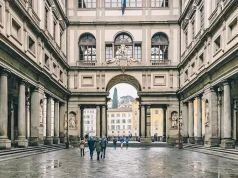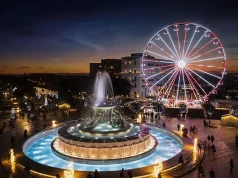
France is a nation known for its magnificent architecture, rich history, and cultural diversity. The country is home to numerous famous structures and monuments.
Millions of tourists visit France each year to view its cultural heritage hotspots.
Let’s take a look at 7 iconic landmarks and monuments in France and see what makes them sights to behold.
Notre-Dame de Paris
The Gothic Notre Dame Cathedral Paris, also known as Notre Dame de Paris, is a well-known church in Paris, France. Its main entrance faces west and is located on the eastern part of Île de la Cité.
The cathedral, one of the first Gothic cathedrals, took about 300 years to complete. Despite being primarily French Gothic, it also features sections from the Renaissance and Naturalism architectural eras, adding to its unique appeal.
The construction process took about 300 years.
Pont du Gard
The Gardon River Aqueduct Bridge, a three-tiered arched structure in ancient Rome, is the highest and most elegant structure still standing. It was a crucial segment of a 30-kilometer canal that transported water to Nîmes with an average gradient of 1 in 18,000.
The bridge, constructed without mortar, is 60 feet high and flat, except for a small gradient fall at the top. The elliptical primary arches reduce wind forces in stormy areas, requiring blocks cut specifically to fit.
Pont du Gard has endured because of its use as a toll bridge during the Middle Ages and was designated a “Monument Historique” by the French government in 1840.
Musée du Louvre
The Louvre, a renowned European museum, was once a Middle Ages fortification. Louis XIV moved to the Palace of Versailles, which now houses the national art collection.
The museum features the Mona Lisa, Leonardo’s Virgin and Child with St. Anne, Vermeer’s The Astronomer, the Scribe, Venus de Milo, and Sleeping Hermaphroditus. It also houses the Sully Wing’s basement model of a medieval stronghold, as well as the Napoleon III apartments on the first level.
The museum’s interior design includes dungeons and moats from the Napoleon III apartments. If these historic sights interest you, consider booking a trip with Band of Brothers to maximize your French experience.
Place de la Bourse
Place de la Bourse, an 18th-century building in Bordeaux, features the world’s largest reflecting pool. Designed by Ange-Jacques Gabriel in 1755, it anchors the Musée National des Douanes and the Bourse.
In 2006, landscape architect Michel Corajou added the Miroir d’Eau, symbolizing the city’s contemporary revival. The building has experienced booms and busts, including the slave trade and the 1960s aeronautics industry.
The 1990s saw a dramatic overhaul under Mayor Alain Juppé. Bordeaux’s economy heavily relies on wine because of its location in renowned wine regions.
Mont Saint-Michel
Mon Saintt-Michel, a tidal island in France surrounded by beautiful mountains, has been standing for over a century and has been a pilgrimage destination and natural strongpoint.
Today, it attracts around three million tourists annually, with shops, dining establishments, and lodging facilities on the island and surrounding mainland.
The most beautiful part of the island is the old Benedictine Abbey, an impressive example of Middle Ages military and religious architecture. Visitors can also take the Tour du Nord to admire the stunning views from the summit.
Eiffel Tower
This one is a no-brainer. It’s often on the list of the top reasons to visit France and is a sight you can’t miss.
Famously constructed as a temporary building, the Eiffel Tower’s huge arches served as the entrance to the World’s Fair in 1889.
The 1,050-foot-tall tower has withstood its 200th anniversary of the French Revolution, but that fair commemorated the revolution’s 100th.
It’s difficult to comprehend how unpopular this industrial feat of engineering was at the time given that it is now a symbol of Paris. Since this was the only spot in Paris where he could not view the Eiffel Tower, author Guy de Maupassant is said to have had lunch here every day.
The Parisian landmark, the first building to reach 1,000 feet, held the title of the tallest building in the world for almost 40 years until the Chrysler Building momentarily surpassed it.
When its original 20-year building license expired, its continued existence was guaranteed by its significance as a radio tower.
The unique bolted iron construction of the Eiffel was preceded in design by the Statue of Liberty framework created by his company in 1886. He was picked because of his knowledge of wind forces, a topic that captivated him for the remainder of his life.
Le Suquet
Climbing Le Suquet’s high steps is one of the best things to do in France. You might imagine a time when the city was still a charming fishing village as you meander through its cobblestone pathways. It was this location on the Mediterranean coast that first drew tourists in.
Le Suquet Hill was once the location of a Roman fort until monks took control of it. The Musée des Explorations du Monde, housed in its castle, currently houses a diverse array of artwork and artifacts.
The 1627 gothic-styled church Eglise Notre-Dame de l’Esperance stands next to it. A favorite place to enjoy the 360-degree panorama over Cannes and the sea is the plaza outside.
Under the watchful eye of the French castle, the cobblestone main boulevard served as Cannes’s original high road. These days, businesses, cafés, and restaurants line the street.
Marché Forville, a fantastic covered market with typical French souvenirs and food and drink selections, is located at the base of the structure. Every day save Monday, when it turns into a flea market, it is open.
France’s timeless charm and breathtaking landmarks make it a dream destination for travelers worldwide. From the Gothic grandeur of Notre-Dame to the iconic silhouette of the Eiffel Tower, each site tells a unique story of history, art, and innovation. Whether you’re wandering through the medieval streets of Le Suquet or marveling at the engineering mastery of Pont du Gard, these remarkable locations capture the essence of France’s cultural heritage. If you’re planning your next adventure, be sure to explore these places to visit in France and experience firsthand the magic and beauty that make the country so unforgettable.





